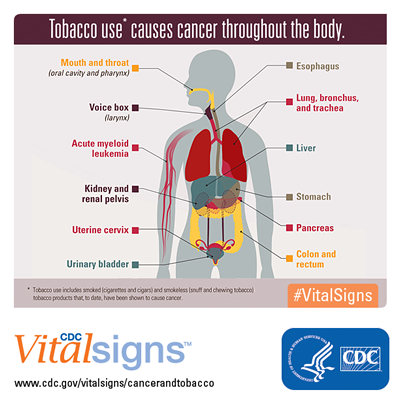Tobacco and Cancer
 If you were asked to describe the relationship between “tobacco smoking” and “cancer,” you might immediately think of lung cancer. It’s true that smoking tobacco products (including cigarettes and cigars) causes almost nine of every ten cases of lung cancer, but smoking can cause cancer almost anywhere in your body, including in the—
If you were asked to describe the relationship between “tobacco smoking” and “cancer,” you might immediately think of lung cancer. It’s true that smoking tobacco products (including cigarettes and cigars) causes almost nine of every ten cases of lung cancer, but smoking can cause cancer almost anywhere in your body, including in the—
- Bladder.
- Blood (acute myeloid leukemia).
- Cervix.
- Colon and rectum.
- Esophagus.
- Kidney and renal pelvis.
- Liver.
- Lungs, bronchi, and trachea.
- Mouth and throat.
- Pancreas.
- Stomach.
- Voice box (larynx).
Health Advice for People Who Use Tobacco or Are Thinking of Using Tobacco
The most important things you can do to avoid health risks from cancer are—
- If you don’t smoke or use tobacco—don’t start!
- If you do smoke or use tobacco—quit!
No matter how long you have smoked, quitting can reduce your risk for cancer and other chronic diseases. Quitting smoking can be hard for many people, but there is a lot of help out there. For more information about quitting smoking, go to smokefree.gov.
How Tobacco Products Cause Cancer
Tobacco smoke has at least 70 chemicals that cause cancer, also known as carcinogens. Every time you breathe in that smoke, those chemicals get into your bloodstream, which carries the chemicals to all parts of your body. Many of these chemicals can damage your DNA, which controls how your body makes new cells and directs each kind of cell to do what it is made for. Damaged DNA can make cells grow differently from how they are supposed to. These unusual cells can turn into cancer.
Secondhand Smoke
Smokers are not the only people who can get cancer from tobacco smoke. People around them—their kids, partners, friends, coworkers, and others—breathe in that smoke, too. Every year, more than 7,300 nonsmokers die of lung cancer from secondhand smoke.
Other Tobacco Products
Smokeless tobacco products, such as dipping and chewing tobacco, can cause cancer, too, including cancers of the esophagus, mouth and throat, and pancreas. Smoking tobacco in a pipe causes lung cancer and increases the risk of cancers of the mouth, throat, larynx, and esophagus, even though pipe smokers don’t inhale the smoke into their lungs.
Health Disparities
Differences between groups of people in their level of health, quality of health care, how many have a particular health problem, and so on, are called health disparities. The groups of people might differ by age, race, income, or some other characteristic. People who are poorer, less educated, or part of certain racial or ethnic groups are more likely to smoke.
More Information
Resources to Help You Quit
- Tips From Former Smokers
This CDC campaign features ads, descriptions of the people featured in the ads and their health conditions, and resources to help you quit. - Get Free Help: Speak to an Expert
Talking to someone about quitting smoking can be the support you might need to see it through. Consider talking to an expert for help. - Smokefree.gov
A Web site that provides free, accurate information and assistance to help you quit smoking and stay tobacco-free.
Related Research
- Page last reviewed: November 9, 2016
- Page last updated: May 23, 2017
- Content source:


 ShareCompartir
ShareCompartir